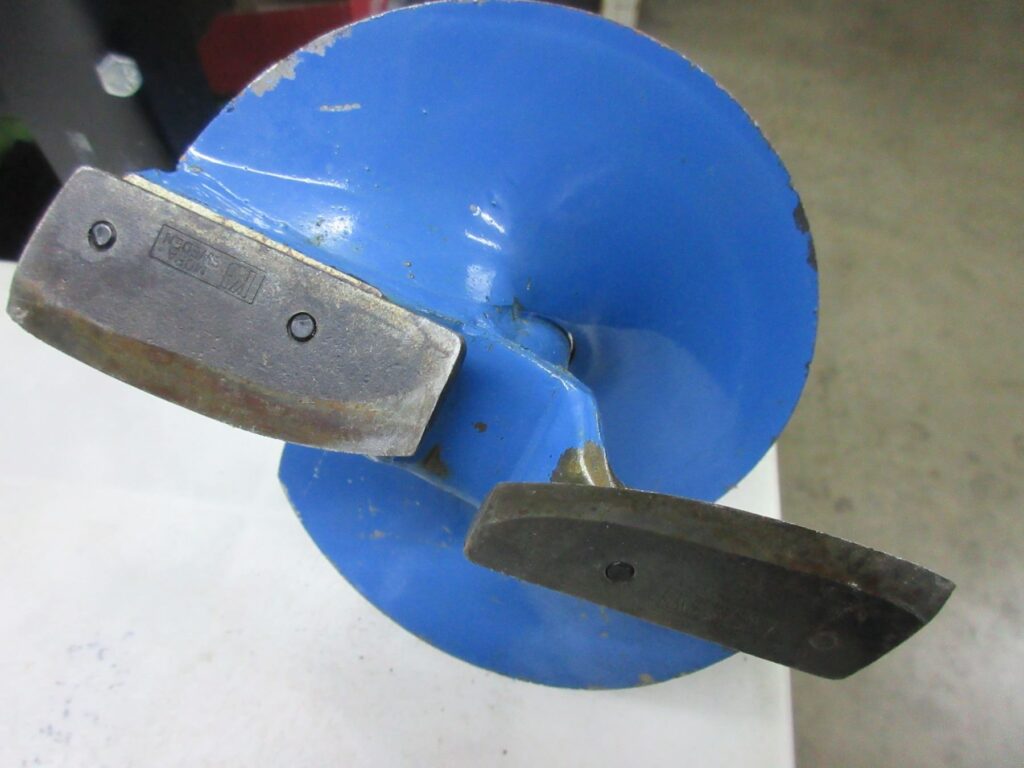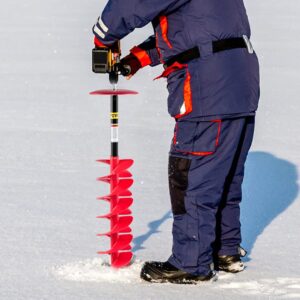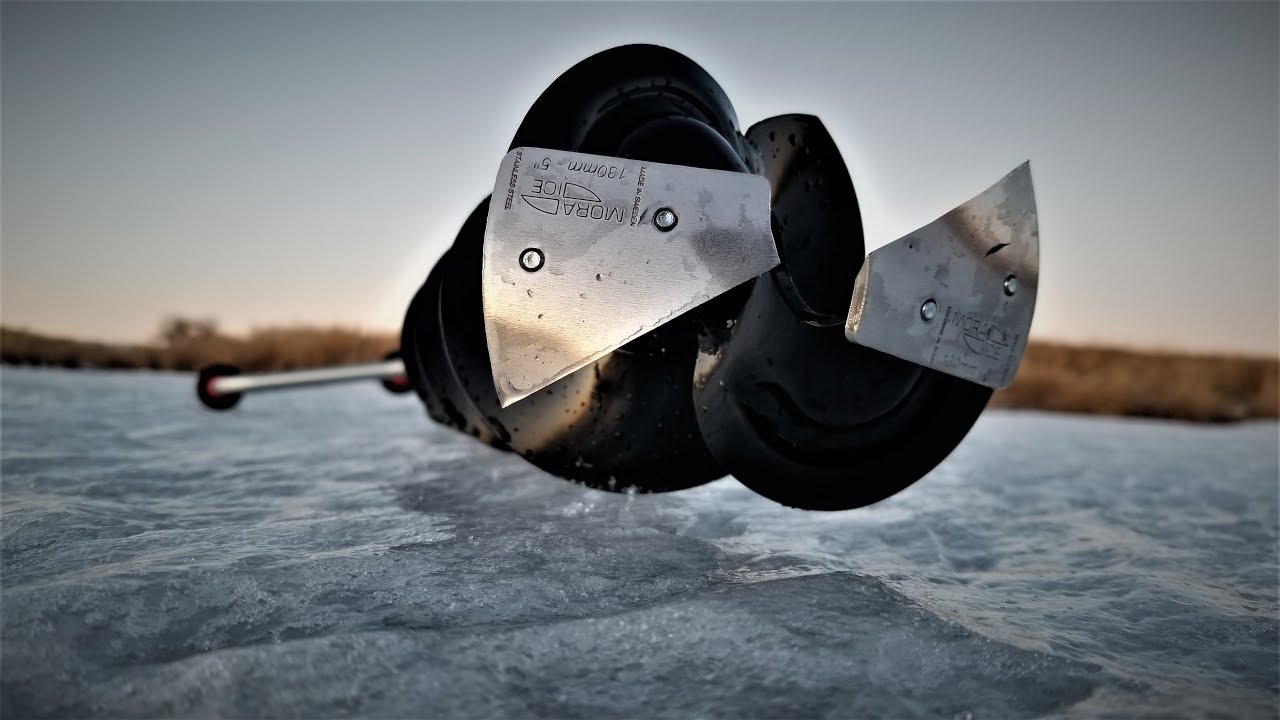A dull auger blade can be a real pain to use. It may take more force to get it into the ice, and if you have been working hard on your hole already, that extra effort can tire you out quickly.
If you want your fishing trip to go smoothly and not end up with a sore back or shoulders, then getting your auger sharpened before each season is essential.
And when you do need an edge put on it again in the middle of winter, knowing how to sharpen an auger yourself will save money over hiring someone else every time.

This guide covers everything from what tools are needed for sharpening an ice auger blade (hint – there’s only one!) all the way through various methods for doing so at home without having to pay anyone else!
Step by Step Auger Blade Sharpening
A dull auger blade can make it difficult to cut through the ice, and can also tire you out quickly. It is important to get your blades sharpened before each season and to know how to sharpen them.
The first step is to clean your blade.
If it has been sitting around for a while, it may be coated with dirt and debris that could clog the holes and prevent the blade from making good contact with the ice when it cuts.
You’ll want to scrub it down thoroughly with soap and water, then rinse well.
Now that the blade is clean, you can start sharpening it.
There are a few ways to do this, but we will cover the most popular methods here.
Method 1: Sharpening With a File
This is the most common way to sharpen an auger blade and can be done with just a few basic tools.
To begin, attach a wood or metal file to a sturdy table.
These can be found at any hardware store for just a few dollars, and most already come with an attachment such as the one shown here that you can screw directly into your workbench.
- Durable monocrystalline diamonds coated full-tang stainless steel.
- Coarse 325 grit (45 microns) for quick edge setting.
- Extra fine 1200 grit (9 microns) for honing.
- 2 grinding surfaces to meet your different grinding needs
- No oil is needed-sharpen dry
To make sure that you achieve the perfect angle, you need to hold the blade firmly between two pieces of wood. The first piece of wood needs to be flat, while the second piece has to be angled slightly upwards.
Now place the blade flat on the bench, and line up the cutting edge of the blade with the edge of the file.
Apply pressure to the blade and begin filing in a back and forth motion.
Make sure to keep the angle consistent as you go.
After a few strokes, check the blade to see if it is sharp enough. If not, continue filing until it is.
Now that the blade has been ground down, you can either leave it like this or finish it off with fine sandpaper.
When using a file, you need to work slowly and carefully. If you speed up too much, you might damage the blade.
Shopping For A Hand File
A hand file is probably the cheapest tool you can buy. It costs less than $10 and is usually sold in packs of 10 or 20.
Hand files are made of steel and have varying degrees of hardness. The harder ones are better for sharpening knives and tools.
On the other hand, softer files are ideal for sharpening ice augers. Soft files are easier to handle and don’t cause the blade to bend when you start working.
They are also relatively safe. Unlike some other sharpening methods, there is no danger of accidentally cutting yourself while sharpening an ice auger.
Because they are so cheap, you should replace them often. In fact, you should do this even if you only use them occasionally.
This is because hand files become dull over time. As soon as they get dull, you need to replace them.
It is recommended that you buy a new file after every five or six uses. This way, you won’t waste any precious material.
Method 2: Sharpening With a Fine Stone
This is another method that can be used to sharpen an ice auger blade, but it requires some special equipment, such as a fine stone.
There are many types of fine stones available, but they all perform the same basic function.
Materials such as whetstone, diamond, and coarse are popular choices.
For example, diamonds are great if you want to sharpen multiple blades at once. On the other hand, they are very expensive and hard to find.
Whetstones are good for cleaning out old blades. Coarse stones are useful for removing nicks and dents.
If you plan on sharpening your blades often, it may be worth the time and money to invest in a diamond stone.
However, if you sharpen just once or twice per season, then a cheaper alternative such as a whetstone will do just as well.
Some people prefer to use a whetstone because they think it gives better results than a file. But it really comes down to personal preference.
If you decide to use a whetstone, you will need to change it regularly. This is because the surface of the stone gets worn away after every few uses.
If you are looking for something that does the job well but doesn’t require constant maintenance, then a whetstone is definitely worth considering.
- Superior Bundle
- Multipurpose Use
- Safety
- Easy To Use
- Premium Quality
If you do have access to this tool, however, it can be a quick and easy way to get a sharp edge on your blade.
Place the fine stone flat on your workbench and place the ice auger blade on top of it with the cutting edge hanging off of one end.
Slide the blade slowly along the stone toward you, maintaining an angle between 23 and 30 degrees.
The same filing rules apply here as they did with the file method.
If you go too fast or lift the blade off of the stone to take a break, you run the risk of chipping or damaging it.
Method 3: Sharpening With a Sandpaper Block
Sandpapers can also be used to sharpen an ice-auger. However, they aren’t as effective as other options.
All you need to do is take sandpaper and rub it along the blade. It works pretty well if you keep the pressure steady.
The great thing about this method is that you can easily find the right angle without having to worry about ruining the blade.
Sandpaper isn’t as durable as a fine stone, you will need to replace it more often.
However, if you want to try this option out, you should probably stick with a light touch. Otherwise, you risk damaging your blade.
- SILICON CARBIDE ABRASIVES: Sandpaper sheet is made of silicon...
- PREMIUM QUALITY: Resin bonded sandpaper ensures paper backing...
- DRY & WET USE: Waterproof sandpaper sheets can be used with...
You want the sandpaper side that is facing up to be about 50-75 grit or rougher.
If you have a very dull blade, this might take some time.
What grit sandpaper is best for sharpening ice auger blade?
It should be noted that it is always better to start with a lower grit paper. This way, you won’t take off too much material while sharpening the blade and you will end up with a nice smooth edge when you are finished.
If you go higher than P80, you might find that the blade becomes dull again.
As far as sandpaper grit goes, 80-grit will work well for this task.
For Professionals
Method 4: Sharpening With a Dremel
This is another method that can be used to sharpen an ice auger blade, but it is a bit more difficult than the other two.
It requires some special equipment, such as a Dremel tool and grinding wheel, that not everyone may have access to.
- Versatile Rotary Tool
- 5 Variable Speed Settings
- 3 Attachments Support
- Convenient Operations
- Great Gift For Friends
If you do have access to these tools, however, it can be a quick and easy way to get a sharp edge on your blade.
To start, remove the blade from the auger and attach it to the Dremel tool according to the manufacturer’s instructions.
Make sure you are wearing safety glasses and turn on the tool.
Slowly move the blade across the grinding wheel, making sure to keep the angle consistent.
Check the sharpness of the blade after a few passes and continue until it is sharp.
Be careful not to apply too much pressure or you could damage the blade.
Method 5: Sharpening With a Grinder
This is a more advanced method, but it can be done with just a few easy steps.
If you have access to a grinder, it will give you a much sharper edge than using a file.
However, you must be careful not to overheat the blade or you could damage it.
To start, attach the blade to the grinder according to the manufacturer’s instructions.

Most require you to secure it with a set screw or locking mechanism of some type.
Now make sure you are wearing safety glasses and turn on your machine on its lowest setting (if there is more than one speed available).
Slowly move the blade across the grinder, making sure to keep the angle consistent.
Check the sharpness of the blade after a few passes and continue until it is sharp.
Be careful not to apply too much pressure or you could damage the blade.
The key to proper blade maintenance is taking your time and being careful while you go through each step.
After sharpening your auger blade in one of these ways, make sure to clean and oil it before putting it away.
This will help to keep it in good condition and prevent rust from forming.
Conclusion
Sharpening your auger blade before each season is an essential step in ensuring that you are able to cut through the ice easily and without too much effort.
How often you will need to sharpen your auger blades will depend on how often you use them and the type of ice you are cutting.
But following these simple steps will help you keep your blades sharp and in good condition for each trip out onto the lake.
Now that you know how to sharpen your auger blades, you can get back to the business of catching fish! Get out there and enjoy the winter fishing season!
Happy ice fishing!









